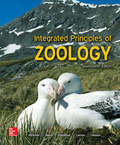
Concept explainers
To determine: The feeding habits of chaetognaths.
Introduction: The word Chaetognatha is derived from the Greek word chaite, long flowing hair, + gnathos, jaws. It depicts the sickle-shaped bristles on each side of their mouth. Chaetognaths are also called as arrow worms. They are marine planktonic predators.
Explanation of Solution
Arrow worms consist of a head, trunk and postanal tail. Their head consists of a large depression called a vestibule which leads to the mouth. This vestibule comprises teeth and edged on each side by curved chitinous spines. The teeth and spines are generally covered by a hood formed from a fold in a neck. A chaetognath in the presence of prey retracts it hood and captures the prey by spreading teeth and spines apart. Once the prey is captured a chaetognath shuts the teeth-spines assembly with tremendous speed. Arrow worms mostly feed on crustaceans, small fish and other chaetognaths.
Want to see more full solutions like this?
Chapter 22 Solutions
EBK INTEGRATED PRINCIPLES OF ZOOLOGY
 Biology: The Dynamic Science (MindTap Course List)BiologyISBN:9781305389892Author:Peter J. Russell, Paul E. Hertz, Beverly McMillanPublisher:Cengage Learning
Biology: The Dynamic Science (MindTap Course List)BiologyISBN:9781305389892Author:Peter J. Russell, Paul E. Hertz, Beverly McMillanPublisher:Cengage Learning
